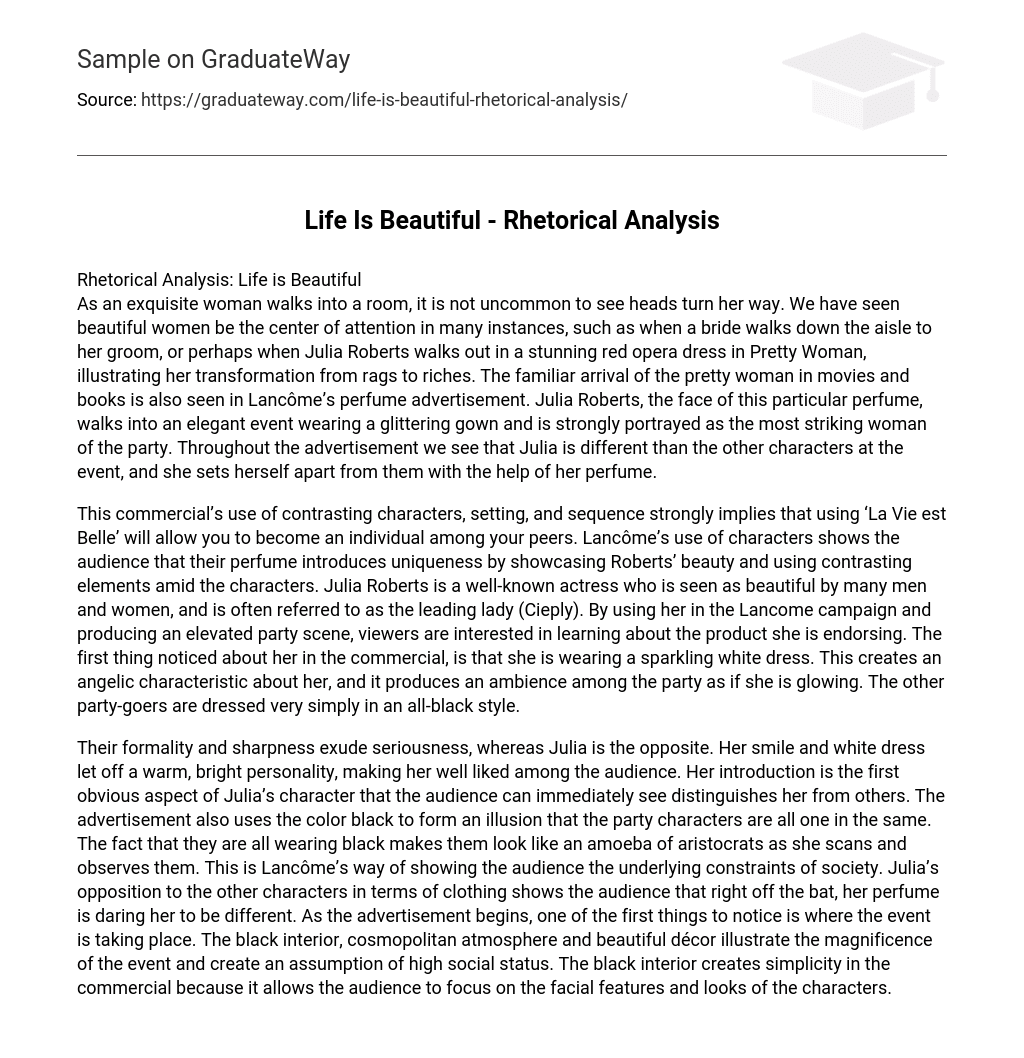Rhetorical Analysis: Life is Beautiful
Beauty has the power to captivate people’s attention, as exemplified by the presence of an exquisite woman in a room. Whether it is during a bridal entrance or in a movie like Pretty Woman, where Julia Roberts stuns the audience with her transformation, beautiful women often become the focal point. This phenomenon is also depicted in Lancôme’s perfume advertisement, featuring Julia Roberts as the face of the brand. In the ad, Julia enters a glamorous event wearing a sparkling gown and effortlessly becomes the center of attention. The advertisement highlights Julia’s distinctiveness from the other partygoers and emphasizes how her perfume sets her apart.
The use of contrasting characters, setting, and sequence in this commercial strongly suggests that using ‘La Vie est Belle’ will make you stand out from your peers. Lancôme highlights uniqueness by showcasing Roberts’ beauty and incorporating contrasting elements between the characters. Julia Roberts, a renowned and beautiful actress often referred to as the leading lady, is featured in the Lancome campaign. The elevated party scene captures viewers’ attention and creates curiosity about the endorsed product she is associated with. The commercial emphasizes Roberts by presenting her in a sparkling white dress, giving her an angelic quality and making her appear radiant amidst the party. In contrast, the other party-goers are dressed simply in all-black attire.
The contrast between Julia and the other characters is evident in their clothing. While they exude formality and sharpness, Julia stands out with her warm smile and white dress, displaying a bright personality that resonates well with the audience. Julia’s introduction immediately sets her apart from the others. The advertisement cleverly uses the color black to create an illusion of uniformity among the party characters, making them appear like an aristocratic amoeba as Julia observes them. Through this visual, Lancôme aims to highlight the underlying societal constraints. Julia’s distinctive attire serves as a symbol of her perfume daring her to be different from the rest. The location of the event is also noteworthy in the advertisement. The black interior and cosmopolitan atmosphere, adorned with beautiful décor, convey the grandeur of the occasion and imply a high social status. By keeping the interior black, the audience can focus on the facial features and expressions of the characters, as well as their jewelry, which further emphasizes their elevated status. Lancôme strategically uses the black interior to draw important attention from the audience.
The party atmosphere is constructed by contrasting dark and light elements, with dim lighting creating sharp images in the room. This sharpness and clarity add a refined touch to the atmosphere, making the party appear more impressive to the audience.
The sophistication of the advertisement suggests that by using Lancôme’s perfume, the audience can become part of a high-class social setting and achieve the elegance seen in Roberts. Lancome wants viewers to feel a sense of luxury from using the perfume, making it important for the audience to feel this way.
The sequence in the advertisement utilizes cinematic strategies to portray Julia’s individualism. When Roberts approaches a large mirror and sees her reflection along with others standing behind her, they all have small silver chains on their wrists. This gives them the appearance of puppets.
The advertisement suggests that all the people at the party are constrained by societal norms. It uses slow motion to focus on individuals, showing them as puppets controlled by strings. This sequencing highlights the ordinary nature of the actions of the upper class, who continue to wear their metaphorical chains. The protagonist examines her own wrists and observes those around her before deciding to free herself from these constraints. This moment represents her ultimate liberation, setting her apart from everyone else. Throughout the commercial, the music adds drama and intricacy, with a climax reached when she becomes aware of herself in the mirror. This moment coincides with the release of tension as she breaks free from her chains.
The purpose of the music in Lancôme’s ‘La Vie est Belle’ is to contribute to the sequence of the advertisement, giving the audience a sense of breaking free from social constructs and feeling beautiful. The dramatic portrayal and climax in the music reflect Julia’s turning point in becoming her own person. By combining characters, setting, and sequence, Lancôme creates a lasting impression on the audience, captivating them with the idea of individualism. This concept is something that viewers are willing to pay for. Additionally, Lancôme’s high social status image adds a sense of sophistication to their product. However, this marketing strategy is ironic because if multiple people buy the same product, they are essentially part of the same social group again, contradicting the idea of individualism. It would be interesting to see how many viewers realize this irony and if it affects their interest in such advertisements.
Works Cited
Cieply, Michael. “The Return of Julia Roberts, Leading Lady.” Nytimes.com. New York Times, 6 Oct. 2011. Web. 13 Sept. 2013. The Purdue OWL. Purdue U Writing Lab, 2010. Web. 14 Sept. 2013. Selfridges. “Lancome La Vie Est Belle with Julia Roberts at Selfridges.” YouTube. YouTube, 28 Aug. 2012. Web. 15 Sept. 2013.





